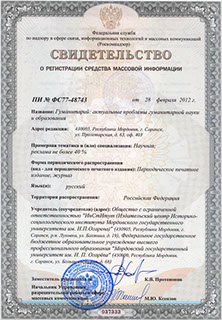ГуманитариЙ актуальные проблемы гуманитарной науки и образования
Russian Journal of the Humanities
ISSN 2078-9823 (Print)
ISSN 2587-7879 (Online)
Navigation
ISSN 2078-9823 (Print), ISSN 2587-7879 (Online)
DOI: 10.15507/2078-9823.048.019.201904.385-393
Ilgizar R. Kaydarov
Kazan higher tank command red banner school (Kazan, Russia),
e-mail: luciakaidarova@mail.ru
Private Farms of Rural Population of the Republic Tatarstan in Historical and Economic Context (2000–2010-ies)
Introduction. In domestic historiography for many decades personal subsidiary plots were viewed as some rudiment of a non-socialist form of farming in the country’s agricultural sector. In accordance with the political principles of party ideologists, most researchers in every possible way emphasized the futility of the personal subsidiary plots and the inevitability of their soon withering away. And at the beginning of the XXI century they re-main a kind of “islands” of small business in the countryside and the main form of earnings for the total mass of rural workers. The main objective of this study is a comprehensive analysis of the current state of personal subsidiary plots of the rural population of Tatarstan in the context of determining the main socio-economic indicators in relation to the study area; identification of the most important development parameters of this form of small business. Materials and Methods. The scientific study is based on source materials from various government departments (including the Tatarstan Statistical Office), newspaper and journal periodicals, as well as data from historical, economic and sociological literature. When writing the article, the author was guided by the principles of historicism, complexity and objectivity. The research is based on the methods of historical science: problem-chronological, comparative-historical, systemic, etc. Results. During the study, the current state and indicators of the development of personal subsidiary plots of the rural population of the Republic of Tatarstan were systematically reviewed, in particular, their participation in the structure of regional gross income. It has been established that the main branches of economic activity of peasant farmsteads are vegetable growing and productive animal husbandry. It is proved that the strengthening of the positions of large investors in the village led to the curtailment of certain branches of production of personal subsidiary plots and their transition to a consumer rate of management. Discussion and Conclusion. The intensive development of various forms of small business in the post-perestroika period, including personal subsidiary plots of the population, intensified the market diversification of the economy of the agricultural sector in general and of high-quality peasant farmsteads in particular. During the forced dismantling of the collective farm and state farm management systems and the formation of new forms of entrepreneurship, peas-ant farmsteads became not only the economic basis for the existence of the rural population, but also a form of self-preservation of many settlements.
Keywords: Russian collective farm peasantry, peasant farmsteads, personal subsidiary farms of the rural population, investors, economic growth indicators, gross output, vegetable growing, animal husbandry, Tatarstan.
For citation: Kaydarov I. R. Private Farms of Rural Population of the Republic Tatarstan in Historical and Economic Context (2000–2010-ies). Gumanitarian : aktual’nye problemy gumanitarnoi nauki i obrazovaniia = Russian Journal of the Humanities. 2019; 19(4): 385–393. (In Russ.). DOI: 10.15507/2078-9823.048.019.201904.385-393.

© Ogarev Mordovia State University. History and Sociology Institute, 2017
68, Of. 411, Bolshevistskaya St., 430005, The editorial office of the scholarly journal «Russian Journal of the Humanities»
Tel.: (8342) 24-25-90; 27-07-11, Fax: (8342) 24-25-90, E-mail: jurnal-econom-hist@isi.mrsu.ru
Designed by A. Napalkov, Email: napalkov@isi.mrsu.ru

